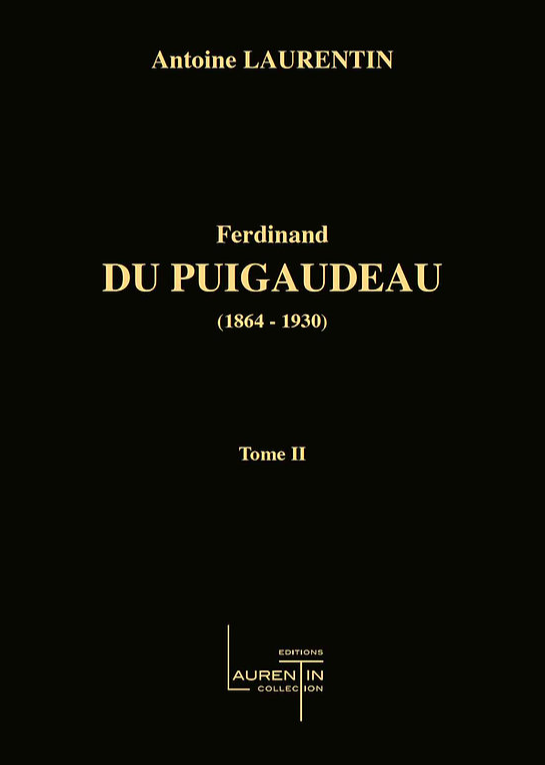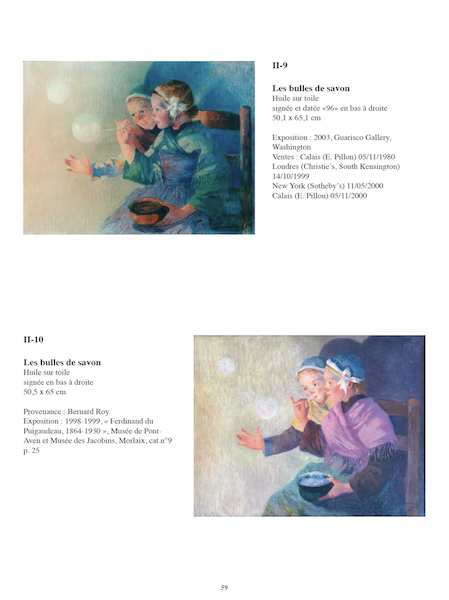The Galerie Laurentin is publishing the Volume II of the Catalogue Raisonné of the paintings by Ferdinand du Puigaudeau
Coming from a family of collectors, and a collector himself before becoming an art dealer, Antoine Laurentin opened his first gallery in 1991 on rue Sainte-Anne in Paris, then moved to 23 quai Voltaire in 2004. In 2013, he opened a second space in Brussels, on rue Ernest Allard.
Specializing in modern art, the Laurentin Gallery organizes solo exhibitions accompanied by catalogs and participates in important art fairs such as TEFAF in Maastricht, Art Brussels in Belgium, Art Genève in Switzerland, the Salon du Dessin and FAB PARIS in Paris, as well as Luxembourg Art Week.
After publishing Volume I in 1989, Antoine Laurentin has just completed Volume II of the catalogue raisonné of Ferdinand du Puigaudeau’s paintings, which will be released at the end of November 2023.
- 300 pages
- About 500 color illustrations
- Size: 23.5 x 32 cm
- Hardcover
- Bilingual: French – English
- Retail price: €150
The subscription is open until November 26, 2023 at the price of €100
Introduction to the catalogue raisonné
Back in 1985, as I started working on Ferdinand du Puigaudeau’s work and undertook the project of a catalogue raisonné, I thought I could easily achieve it within a few years. This catalog’s first volume counted 257 paintings and was published in 1989, thanks to Galerie Salvador. The first biography of the artist was written, drawn from the family archives. This first publication allowed the discovery, provided the collectors with a better understanding, and gave an international recognition to Puigaudeau and his work.
The elaboration of a catalogue raisonné is a long-time process, for rediscovering unknown artworks takes time. Gallery and museum exhibitions have greatly contributed to this long-time endeavor.
34 years later, and thanks to Mrs Caroline Jouquey-Graziani’s active contribution, essential help and support for almost twenty-five years by my side, the Tome II of catalogue raisonné is now being published. Our book contains close to 500 paintings, bringing Puigaudeau’s production to a little bit more than 700 works, which is a typical amount for an artist of his generation.
Yet the adventure goes on, and it is very likely that more works come up as soon as this second volume is published…
Antoine Laurentin
Ferdinand du Puigaudeau (1864 – 1930)
Some biographical elements
Light in all its forms exerted a continuing fascination in the work of Ferdinand du Puigaudeau.
We will therefore try to understand the development and evolution of his creative process from the outset. He was introduced to painting by his uncle Henri de Châteaubriant, and received a typical 19th century academic artistic education. The old masters who served as references at that time had a deep influence on him, particularly the Caravaggesques.
His research, which was strongly inspired by the Italian masters and the northern schools, took as its starting point the artificial light of a candle illuminating a face, often a female face, irradiating everything around it, with the rest of the composition fading into a mysterious semi-darkness (see his submission to the Salon de la Société nationale des beaux-arts in Paris in 1890).
Following his second stay in Pont-Aven (1895-1898), his work freed itself from academic constraints.
Very quickly these intimate genre scenes were transposed into nocturnal landscapes, such as village squares, where sometimes only a fleeting silhouette crosses the painting. Then, probably under the influence of the Brittany country and its traditions, but also of his companions, Laval and Gauguin, whom he refused to copy slavishly, the lighting of lanterns and candles spread throughout the composition, which went from being static to dynamic, carried away by the movement of the procession or festival.
The light is no longer treated using a gradation technique, but is animated, vibrating. Puigaudeau used a preparatory coloured undercoat technique, ranging from pink to orange, to accentuate the shimmering effect. In the paintings of this period, Puigaudeau achieved total mastery of the technique of rendering artificial light as perceived by man.
Around 1900, he moved to Sannois in the Paris region, where his pictorial vision evolved further, abandoning (intermittently) night views for sun-drenched rural landscapes.
It seems that it was at this time that he began to paint variations of the same subject at different times, in the purest Impressionist tradition. In a perpetual quest to renew his inspiration, he tried his hand at nudes, but did not persevere in this direction, although some charming paintings have come down to us.
In 1904, his trip to Venice enabled him to combine different aspects of his pictorial style that he had never brought together before: the natural light of the moon, the artificial light of candles and lanterns and sometimes the dazzle produced by the explosion of fireworks.
By this time, Puigaudeau seemed to have reached the limits of the chromatic possibilities offered by artificial lighting, and he gradually abandoned this type of painting. After 1910, fairground and merry-go-round subjects virtually disappeared from his work.
From then on, he focused all his attention on natural sources of light: the sun and the moon, and endeavoured to transcribe in detail the pictorial effects produced in a given environment.
The rendering of skies and the atmospheric effects of clouds attracted all his attention, and were fundamental elements of his painting after 1910.
Skies were his specialty,” said his wife. Few artists composed them as well as he did. We cannot notice how well his clouds accompany his landscapes. He never copied them slavishly, but gave them the form and place most necessary to the harmony of the composition.
Puigaudeau accentuated the serial aspect of his paintings to better ‘mark’ the unreal side of his compositions.
The theme of windmills and the landscapes of the Grande Brière are familiar, but always shrouded in mystery.
Most of his paintings were done in and around the Guérande peninsula. Puigaudeau worked from the ground up, on his bicycle, his equipment firmly attached to the luggage rack.
From his long walks, he would bring back small pochades on panel with great freedom of execution. These were later used to create his easel paintings.
An ingenious process of transferring drawings onto tracing paper enabled him to work with variations in light while keeping the same subject. The reality of the place was then interpreted by the painter according to his imagination.
It is not uncommon for buildings, particularly mills, to be transplanted to sites that are geographically far removed from reality.
This partly imaginary geography is the source of a world where the atmosphere of dreams and wonder prevails.
Alphonse de Châteaubriant wrote a letter in his time, perfectly analysing the personality and talent of his cushion:
“There is certainly in you, in your nature, the essence of the contemplative. The fact that you have kept your gaze tirelessly fixed on your Kervaudu for twenty-five years covers a world, a kind of artistic asceticism, thanks to which your vision has developed, instead of weakening, and has become soaked in spiritual energy.”
Antoine Laurentin
Volume II of the Catalogue Raisonné
of Ferdinand du Puigaudeau’s Paintings
edited by Antoine Laurentin
- 300 pages
- Approximately 500 color illustrations
- Size: 23.5 x 32 cm
- Hardcover
- Bilingue : français – anglais
- Publication scheduled for late November 2023.
- Retail price: €150
Subscription price: €100 Until November 26th



